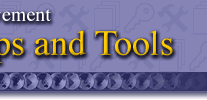|
 |
PI Facilitator, PI Team (should include local counterparts) |
 |
|
Now that you have asked your clients their opinions of the situation, it's time to explore the organization with your own eyes. The objective is to see how things work, start to fill in the picture and locate possible problematic areas. Don't stop when you've found one problem — the whole process should be understood and mapped out. By the end of this step, you should be able to answer the following questions:
- What are the overall goals of the organization?
- How is the organization structured? What does it look like?
- Which components (or units) of the organization affect the problem area?
- What are the processes and functions of these components? How do they go about their work?
- What are the products or accomplishments that correspond to each process?
- How do the components/processes/functions relate? Where do they interact or intersect?
- Can you identify possible problem areas already?
Process Steps:
- To further understand the whole situation, create a map of the organization, system and/or process. Each piece of this map can then be investigated as a possible location of the problem and related performer(s). (Use Cross-Functional Flow Chart, Cross Functional Roles and Responsibilities Matrix, Job Model Guide.)
- Interview the leaders/managers of distinct areas. (Use the Problem Pentagon.)
- Visit clinics, hospitals. (Use Data Gathering Methods.)
|

